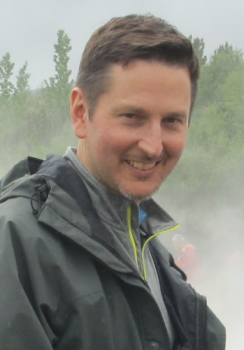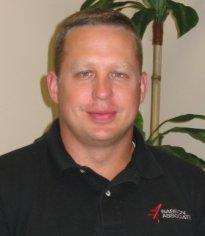Team
Barron Associates’ most valuable asset and key to success is its team and their leadership and innovation. The team is an eclectic crowd with diverse backgrounds. A commonality is the desire to explore complex systems and discover ways to improve their performance, safety and reliability. This desire leads to ongoing professional development through interaction with the wider technical community and continued education. A majority of the team carries advanced degrees in engineering or mathematics.

B. Eugene Parker, Jr., Ph.D.
Senior Technical Director and President
Dr. Parker joined Barron Associates in 1990, where he has led many projects; these have included the detection, classification, and prognostication of faults in mechanical (e.g., helicopter gearboxes, aircraft structures, sensors, and actuators) and electrical (e.g., shipboard distribution) systems; signal conditioning for improved detection of torpedoes by surface ship passive sonar; active noise and vibration control in auxiliary power units; fault management, operating control, and reconfiguration in power-electronics-based shipboard power delivery systems; detection of faults in permanent magnet machines; development of new algorithms for trauma triage and injury severity assessment in field settings; formulation of new approaches for decision-making under uncertainty; development of algorithms for trauma triage and injury severity assessment in field settings; development of algorithms for retrospective medical quality-of-care assessment and health care institution ranking; development of algorithms for prediction of in-hospital adverse outcomes and total charges associated with nurse staffing variations; development of a low-cost fall monitoring technology for geriatric subjects; and development of a low-cost, high-performance physical activity monitoring technology
From 1985-1990, Dr. Parker worked for Sperry Marine Inc., where he was responsible for development and application of signal processing, neural network, and artificial intelligence technologies. His work included, in part, development of neural networks for vibration signature analysis, radar automatic target recognition, and electronic warfare support measures post-detection signal processing; development of Kalman filters to estimate submarine and surface ship inertial navigation system errors; development of expert systems for diagnostic maintenance and performance monitoring of the spinning-wheel gyroscope and marine ring-laser gyroscope inertial navigators; design and management of command, control, communications, and intelligence (C3I) data fusion simulation studies; and teaching a course on inertial navigation theory.
Dr. Parker has Ph.D. and M.E. degrees in Biomedical Engineering from the University of Virginia, awarded in 1988 and 1981 respectively, and both a B.S.E. in Engineering Analysis and Design (Electrical Engineering) and a B.A. in Mathematics, awarded by the University of North Carolina-Charlotte in 1978. His graduate thesis involved nonlinear system identification of the respiratory center of the brain. Dr. Parker is a member of the IEEE and Sigma Xi.
Alec J. Bateman, Ph.D.
Technical Director
Dr. Bateman received a B.S. degree in Electrical Engineering from Rensselaer Polytechnic Institute in 1997, an M.S. in Electrical Engineering from the University of Virginia in 2002, and a Ph.D. from the University of Virginia in 2011. His Masters research was on stability analysis and control design techniques for systems with actuator saturation. His Doctoral research was on validation methods and tools for feedback control laws, with an emphasis on aerospace applications. He joined Barron Associates in 1997, and continued working for Barron Associates throughout his graduate studies.
Dr. Bateman leads a research group that is developing a variety of technologies to enhance the safety of air vehicle operations. Assurance and certification of advanced algorithms, particularly guidance, navigation, and control (GNC) algorithms, are one significant research area for this group. Work has included development of novel analysis approaches for GNC algorithms, and implementation of simulation-based testing tools that integrate these analysis methods to enhance their efficiency. Recently, stochastic modeling tools based on generalized Polynomial Chaos (gPC) have been developed and employed to validate path planning algorithms for unmanned vehicles, and run-time assurance (RTA) methods have been applied to address challenges in the certification of control methods for eVTOL vehicles.
Man-machine interactions and aeromedical factors have played an important role in a number of the research efforts in Dr. Bateman’s group. For manned aircraft, the flight environment often causes the vestibular system to provide misleading signals that can cause various “illusions”, especially when the pilot lacks an external visual reference. A recent research effort developed a tactile attitude indicator system that is worn around the torso. The goal of this system is to mitigate spatial disorientation, and an initial flight evaluation demonstrated the feasibility of using the device to control an airplane with no visual reference or instruments. Though the flight environment presents important challenges for onboard pilots, it also provides many useful cues that are unavailable to the ground-based pilots of Unmanned Air Systems (UAS), and technologies are needed to help UAS pilots maintain situational awareness, for example, awareness of the turbulence environment. Dr. Bateman is leading the development of a system to automatically quantify turbulence using existing sensors on unmanned air vehicles, and to communicate actionable information regarding the turbulence environment to a ground-based pilot. He is also leading an effort to customize this technology for the unique needs of Urban Air Mobility vehicles, including operations in the urban canyon.
Other areas of research in Dr. Bateman’s group include development of biomedical devices, and development of novel unmanned air vehicles for specialized deployment scenarios. Recent biomedical efforts include development of a blink-based communication system for patients with ALS, and development of a tablet-computer-based field side concussion assessment tool. Recent air vehicle development work includes creation of a small vehicle deployable from larger manned aircraft to perform atmospheric sensing in hurricanes, and development of a range extension system for munitions.
Dr. Bateman holds a private pilot certificate, with single-engine land, single-engine sea, instrument airplane, and glider ratings. He also holds a Part 107 SUAS operator certificate and has served as the pilot for several SUAS flight tests, including tests of novel vehicle designs and novel guidance and control algorithms.

Rick Adams, Ph.D.
Technical Director
Dr. Adams entered commissioned service in the Air Force in 1989 as a Distinguished Graduate of the US Air Force Academy (USAFA). His academic performance resulted in a full scholarship and follow-on assignment to the University of Washington in Seattle, WA where he was awarded the degree of Master of Science in Aeronautical and Astronautical Engineering. In 1990, he became a Stability and Control Engineer at Wright Laboratory, Wright-Patterson AFB, Ohio, applying recently acquired technical skills to improving the flying qualities and performance of AF aircraft. After completion of six months of intensive language training at the Defense Language Institute in Monterey, CA, he was assigned to the Paris Embassy with duty in Toulouse, France. He worked from 1994 to 1996 at the Research Center of Toulouse as an AF Engineer and Scientist Exchange Officer, developing parameter-varying control techniques for aerospace applications.
Dr. Adams returned to the University of Washington to study human machine interfaces to virtual reality. There, he developed control theory for force feedback cueing devices and was awarded the degree of Doctorate of Philosophy in the Department of Electrical Engineering in 1999. He was subsequently assigned to the Office of the Under Secretary of the Air Force in Washington, D.C. As the Chief of the Research and Development Division, he led an eight-officer joint service team managing advanced technology demonstration programs. In this role, he was recognized as the Field Grade Officer of the Year in 2001. In 2004, he completed Air Command and Staff College in-residence at Maxwell AFB, AL as a Distinguished Graduate. From there he was reassigned to Headquarters, AF Space Command where, as Chief of the Space Superiority Program Integration Branch, he was responsible for developing, integrating, and advocating for space control plans, programs, and budgets. He returned to USAFA as an Assistant Professor in the Department of Astronautical Engineering in 2007, where he served as Navigation, Guidance, and Control Division Chief and Deputy Director of the Space Systems Research Center.
In June 2009, he retired from the Air Force and joined Barron Associates, Inc (BAI). At BAI, he has led diverse projects as Principal Investigator for research including a virtual worlds-based stroke rehabilitation system, assistive technology for individuals who are blind or vision impaired, haptic space suit gloves for NASA, spacecraft autonomy, and a plasma sensor experiment on the International Space Station.
Notable recognition includes the AIAA Best Paper Award for the top publication at the Guidance, Navigation, and Control Conference, the AF Scientific Achievement Award, and AF Research Laboratory’s General Foulois Award. Military decorations include the Defense Meritorious Service Medal, AF Meritorious Service Medal, AF Commendation Medal, and Joint Service Achievement Medal.
Dr. Adams is author of over 50 refereed journal and conference publications. He is a senior member of both the IEEE and AIAA, and has served as an Associate Editor for the IEEE Transactions on Haptics and as an Associate Editor, Publicity Chair, and Sponsorships Chair for the IEEE World Haptics Conference (WHC).
Brian Clark
Technical Director
Mr. Clark graduated summa cum laude from Rensselaer Polytechnic Institute in 1999. He first joined Barron Associates as an intern in 1997 through Rensselaer’s “Cooperative Education” program and returned as a full-time employee in 1999.
His work at Barron Associates involved extensive mathematical modeling, neural network synthesis, and algorithm development, and substantial work in signal processing, software engineering, statistics, and data mining. He has performed as Principal Investigator, technical lead, and/or project manager on a range of diverse R&D efforts, a sampling of which is described below.
His initial work involved the development of a diagnostic and prognostic capability for reliable, non-destructive, and non-intrusive determination of the state of rotating machinery components (gears and bearings) using Statistical Change Detection (SCD) in the Bispectral Domain, and synthesis of dynamic Artificial Neural Network (ANN) models for the U.S. Army to assist with battlefield trauma management and minimize loss of life from injuries sustained by combat soldiers.
As part of the Helicopter Active Control Technology (HACT) program, Mr. Clark trained neural networks that were used to predict immediate-future aircraft behavior in a flight simulator. His work was key to the project’s success, including several patents and several published technical papers.
As part of a NASA contract, he implemented a methodology for detecting and isolating sensor and actuator faults in complex dynamical systems, such as aircraft flight control systems and turbine engines, by exploiting analytic redundancy that exists among various subsets of available actuator input and sensor output data.
In 2001, his research interests shifted to biomedical devices, applications, and interventions. His past efforts have included:
- development of an Internet-based personal fitness and nutrition assistant that automatically recommends an exercise regime and nutrition plan tailored to an individual’s goals, capabilities, and preferences;
- formulation of algorithms to predict seizure onset due to hyperbaric oxygen (HBO) exposure for Navy divers;
- development of an intervention that uses advanced image processing techniques to assist breast cancer patients experiencing distress during the course of chemotherapy treatment;
- development of a handheld computer system for chronic pain assessment based on multidimensional Item Response Theory and Computerized Adaptive Testing;
- development of a handheld computer intervention to facilitate weight loss;
- development of a novel, cellular phone-based dietary assessment system;
- implementation of an unobtrusive, non-invasive methodology for predicting individual and team cognitive readiness to perform critical missions for the Department of Defense;
- synthesis of automated algorithms to analyze objective motion data and ascertain the functional impact of pain in chronic pain patients.
Mr. Clark has led the development of several leading-edge biomedical technologies, most recently:
- development and validation of a fourth-generation, chest-worn energy expenditure and heart rate monitor, called the HeartWing, which outperformed competing devices in a head-to-head comparison;
- development of a real-time, wireless, noninvasive physiologic measurement system for rats and mice;
- development of an automated system to train rats to safely detect landmines for the Army;
- development of a novel, wrist-worn fall detection system for seniors that uses unique, patented sensing modalities to achieve superior sensitivity and specificity;
- development of a fall risk assessment system for rehabilitation hospitals using Bayesian statistics;
- development of a system for early identification of developmental disorders in very low birth weight infants using advanced mathematical techniques applied to six-degrees-of freedom inertial sensing of limb motions;
- development of a head-worn balance prosthesis for individuals with chronic postural instability.
Currently, his work is focused on development of products and processes for elder care and prevention (particularly fall prevention and detection), improvements in diagnostic techniques for sleep disorders, and methods for noninvasive energy expenditure assessment.

Jason O. Burkholder, Ph.D.
Principal Research Scientist
Dr. Burkholder received a Ph.D. degree in Electrical Engineering from the University of Virginia in 2010, an M.S. degree in Electrical Engineering from the University of Virginia in 1997, and a B.S. degree in Systems Engineering from the United States Naval Academy in 1995. His dissertation involved the design of adaptive diagnostic algorithms that tolerate changing system dynamics during the normal equipment aging process while maintaining fault sensitivity.
From 1998 to 2003, Dr. Burkholder worked for Sperry Marine, a unit of Northrop Grumman Systems Corporation. At Sperry Marine, he was a control systems and software engineer in the Navigation and Controls department, where he designed, coded, and tested at sea new control algorithms and adaptive tuning algorithms that are now included in Sperry Marine’s commercial autopilots. He also wrote and validated ship simulations for numerous commercial and military vessels, including DDG 51 and LPD 17 class ships. These models are used for the purposes of autopilot and track control algorithm development and testing as well as for LPD 17 Steering and Integrated Bridge System Operator Training. Dr. Burkholder served as Project Lead for the CG 47 Class Steering and Integrated Bridge System upgrade and the LHD/7 modernized steering system development. In addition, he served as control systems engineer for Sperry Marine’s active fin stabilizer product and wrote ship and control system simulations to predict and evaluate fin stabilizer performance and recommend appropriate fin sizes for new ship designs. His work on steering and track control systems provided opportunities to ride numerous commercial and military vessels around the world for the purposes of evaluating and improving Sperry Marine’s heading and track control systems and roll stabilization systems. In December 2001, Dr. Burkholder received the Sperry Marine Engineering Excellence Award, an annual award recognizing the Company’s outstanding young engineer.
Dr. Burkholder began working for Barron Associates in 2002 and joined the firm full-time in January 2003. He has led several projects at Barron Associates, including: the development of a comprehensive methodology for applying statistical change detection techniques to the analysis of residual signals generated in analytic redundancy schemes for fault detection and isolation in dynamical systems; the development and simulation of fault detection and isolation schemes for marine diesel engines; the development and simulation of advanced high-speed algorithms for detection and isolation of faults in zonal, grounded shipboard electrical power systems being considered for future U.S. Navy all-electric ship designs; the development and simulation of optimization algorithms for reconfigurable shipboard electrical power systems; the design and simulation of a physical arrangement and a control system for permanent magnet motor steering gear; the development of automatic swimmer recognition algorithms for a waterside intrusion detection radar; the design and implementation of adaptive control algorithms to achieve active flow control objectives using synthetic jet actuators; the design of prognostic health monitoring algorithms specifically designed for dynamic operating conditions; the design of an autonomous health monitoring system for hybrid propulsion military vehicles; a software tool for analyzing freeplay-induced aeroservoelastic flutter; the design of adaptive diagnostic algorithms that tolerate changing system dynamics during the equipment aging process while maintaining fault sensitivity; a fuel usage monitor and economizer for heavy trucks; a 3D corrosion mapping system for aircraft components having complex geometries, and; algorithms for the prediction of Type II hot corrosion in turbine disks.
